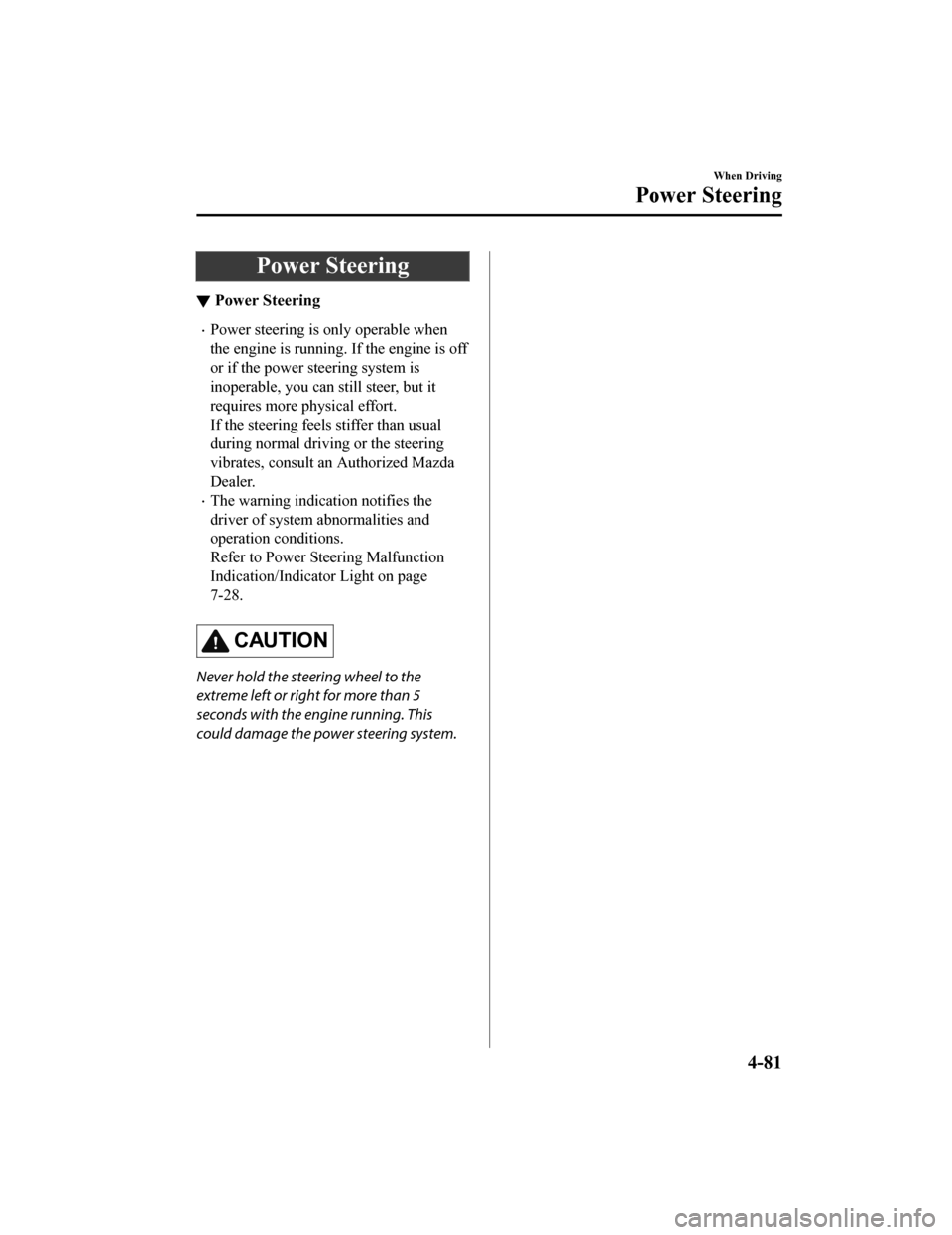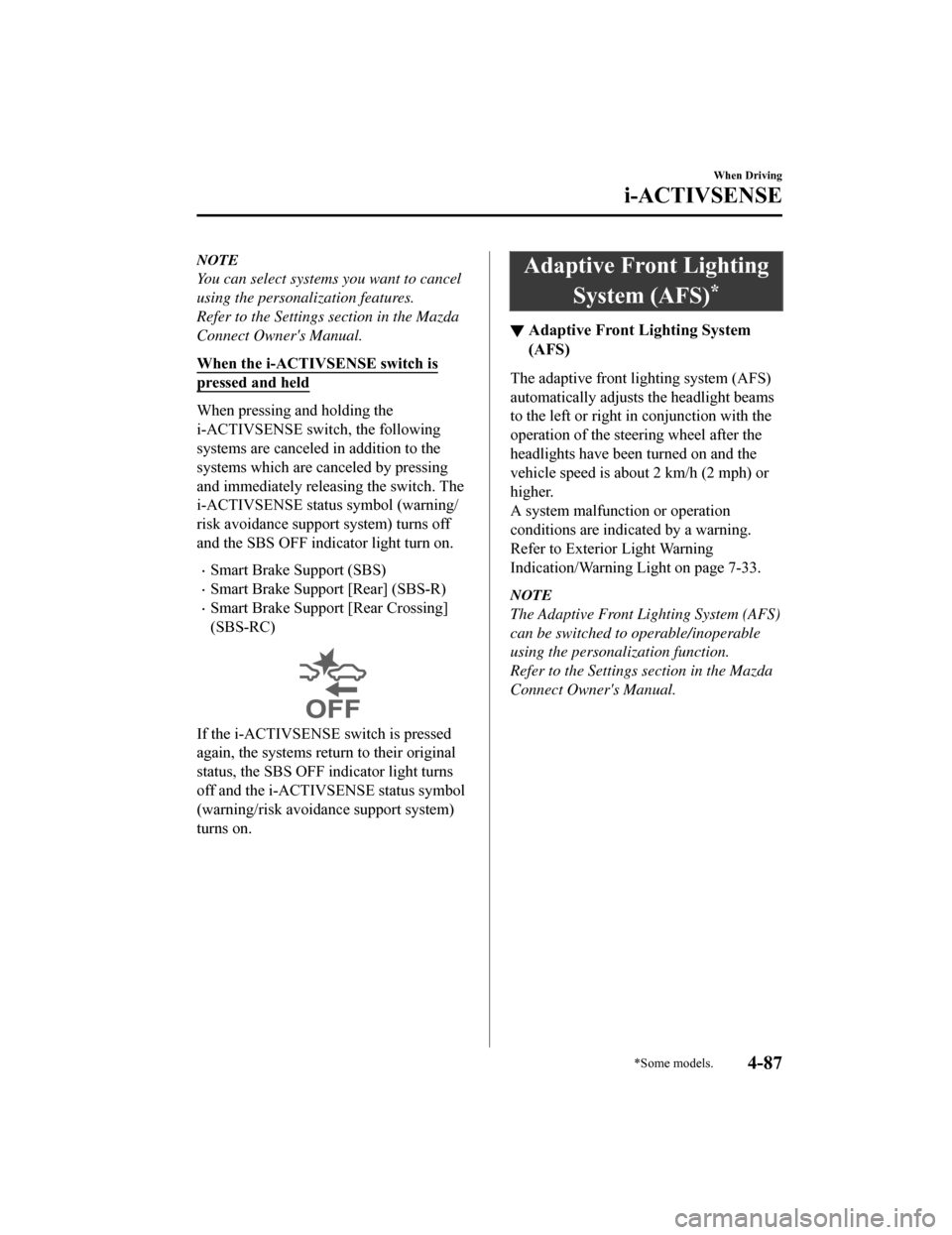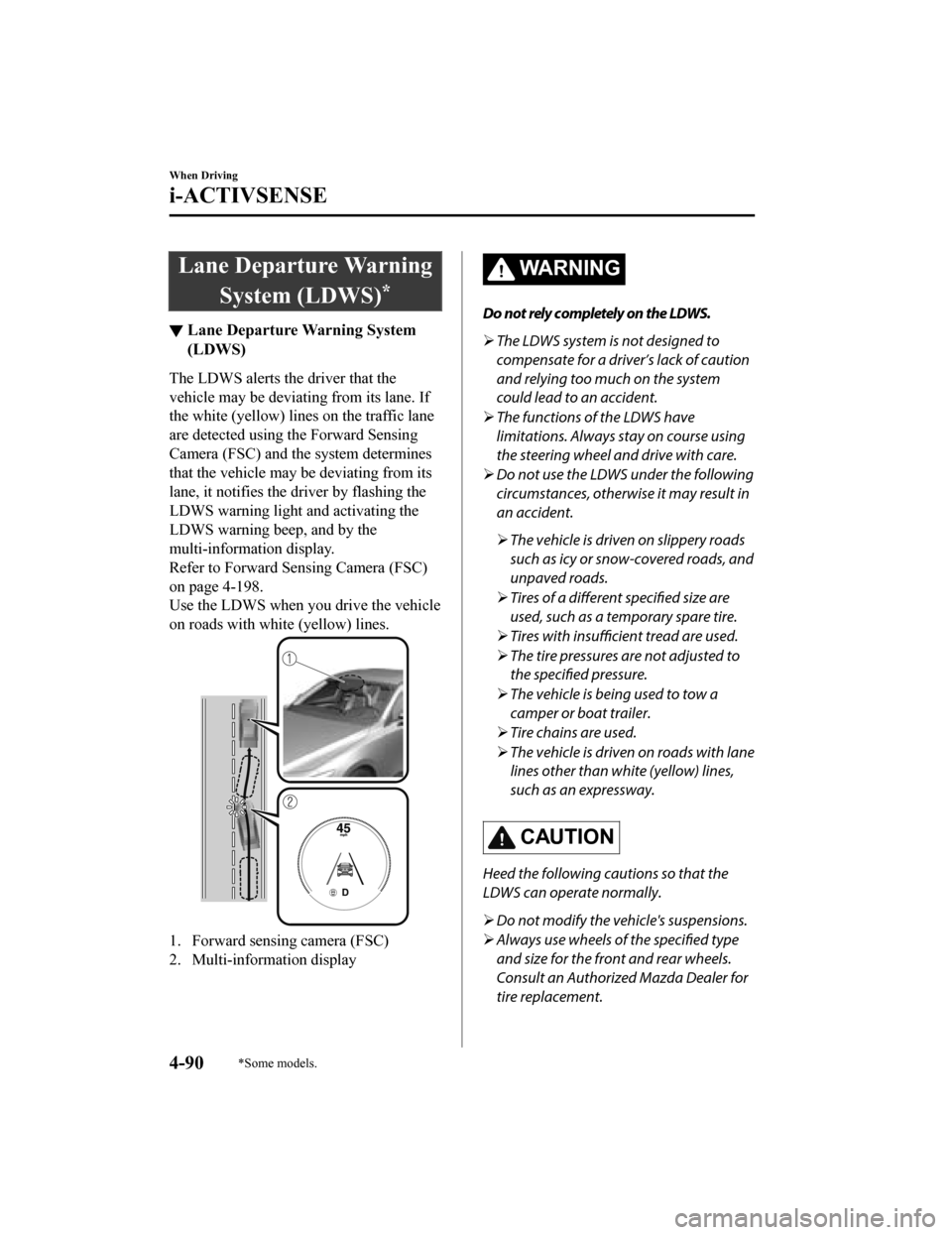steering wheel MAZDA MODEL 3 HATCHBACK 2019 (in English) Owner's Manual
[x] Cancel search | Manufacturer: MAZDA, Model Year: 2019, Model line: MODEL 3 HATCHBACK, Model: MAZDA MODEL 3 HATCHBACK 2019Pages: 592, PDF Size: 12.19 MB
Page 220 of 592

i-ACTIV AWD Operation*
▼i-ACTIV AWD Operation
AWD provides excellent drivability on
snow-covered and ice-packed roads, sand
and mud, as well as on steep slopes and
other slippery surfaces.
A system malfunction or operation
conditions are indicated by a warning.
Refer to Contact Authorized Mazda
Dealer and AWD Warning Indication/
Warning Light on page 7-30.
WA R N I N G
Never spin a wheel that is
off the ground:
Spinning a wheel that is off the ground as a
result of the vehicle being stuck or in a
ditch is dangerous. The drive assembly
could be seriously damaged which could
lead to an accident or could even lead to
overheating, oil leakage, and a fire.
▼ AWD Driving
This vehicle has not been designed for the
purpose of off-road driving or rallies. Do
not attempt to drive over uneven or rocky
surfaces, or across rivers.
Although this vehicle is equipped with
AWD, acceleration, steering and braking
operations should be conducted in the
same manner as with a non-AWD vehicle,
with the emphasis placed on safe driving.
▼Tires and Tire Chains
The condition of the tires plays a large role
in the performance of the vehicle.
Moreover, to prevent adverse effects to the
drive assembly, please note the following:
Tires
When replacing tires, always replace all
front and rear tires
at the same time.
All tires must be of the same size,
manufacture, brand and tread pattern.
Pay particular attention when equipping
snow or other types of winter tires.
Do not mix tread-worn tires with normal
tires.
Inspect tire inflation pressures at the
specified periods adjust to the specified
pressures.
NOTE
Check the tire inflation pressure label
attached to driver's door frame for the
correct tire inflation pressure.
Make sure to equip the vehicle with
genuine wheels of the specified size, on
all wheels. With AWD, the system is
calibrated for all 4 wheels being of the
same dimensions.
Tire chains
Install tire chains to the front tires.
Do not use tire chains on the rear
wheels.
Do not drive the veh icle faster than 30
km/h (19 mph) with the tire chains
installed.
Do not drive the vehicle with tire chains
on road conditions other than snow or
ice.
▼ To w i n g
If the vehicle requires towing, have it
towed with all 4 wheels completely off the
ground.
Refer to Towing Description on page
7-22.
When Driving
i-ACTIV AWD
4-80*Some models.
Mazda3_8HE9-EA-18K_Edition1
2018-10-17 19:05:10
Page 221 of 592

Power Steering
▼Power Steering
Power steering is only operable when
the engine is running. If the engine is off
or if the power steering system is
inoperable, you can still steer, but it
requires more physical effort.
If the steering feels stiffer than usual
during normal driving or the steering
vibrates, consult an Authorized Mazda
Dealer.
The warning indication notifies the
driver of system abnormalities and
operation conditions.
Refer to Power Steering Malfunction
Indication/Indicator Light on page
7-28.
CAUTION
Never hold the steering wheel to the
extreme left or right for more than 5
seconds with the engine running. This
could damage the power steering system.
When Driving
Power Steering
4-81
Mazda3_8HE9-EA-18K_Edition1
2018-10-17 19:05:10
Page 227 of 592

NOTE
You can select systems you want to cancel
using the personalization features.
Refer to the Settings section in the Mazda
Connect Owner's Manual.
When the i-ACTIVSENSE switch is
pressed and held
When pressing and holding the
i-ACTIVSENSE switch, the following
systems are canceled in addition to the
systems which are canceled by pressing
and immediately releas ing the switch. The
i-ACTIVSENSE status symbol (warning/
risk avoidance support system) turns off
and the SBS OFF indicator light turn on.
Smart Brake Support (SBS)
Smart Brake Support [Rear] (SBS-R)
Smart Brake Support [Rear Crossing]
(SBS-RC)
If the i-ACTIVSENSE switch is pressed
again, the systems return to their original
status, the SBS OFF indicator light turns
off and the i-ACTIVSENSE status symbol
(warning/risk avoidance support system)
turns on.
Adaptive Front Lighting
System (AFS)
*
▼Adaptive Front Lighting System
(AFS)
The adaptive front lighting system (AFS)
automatically adjusts the headlight beams
to the left or right in conjunction with the
operation of the steering wheel after the
headlights have been turned on and the
vehicle speed is about 2 km/h (2 mph) or
higher.
A system malfunction or operation
conditions are indicated by a warning.
Refer to Exterior Light Warning
Indication/Warning Light on page 7-33.
NOTE
The Adaptive Front Lighting System (AFS)
can be switched to operable/inoperable
using the personalization function.
Refer to the Settings section in the Mazda
Connect Owner's Manual.
When Driving
i-ACTIVSENSE
*Some models.4-87
Mazda3_8HE9-EA-18K_Edition1
2018-10-17 19:05:10
Page 230 of 592

Lane Departure WarningSystem (LDWS)
*
▼Lane Departure Warning System
(LDWS)
The LDWS alerts the driver that the
vehicle may be deviating from its lane. If
the white (yellow) lin
es on the traffic lane
are detected using the Forward Sensing
Camera (FSC) and the system determines
that the vehicle may be deviating from its
lane, it notifies the driver by flashing the
LDWS warning light and activating the
LDWS warning beep, and by the
multi-information display.
Refer to Forward Sen sing Camera (FSC)
on page 4-198.
Use the LDWS when you drive the vehicle
on roads with white (yellow) lines.
1. Forward sensing camera (FSC)
2. Multi-information display
WA R N I N G
Do not rely completely on the LDWS.
The LDWS system is not designed to
compensate for a driver’s lack of caution
and relying too much on the system
could lead to an accident.
The functions of the LDWS have
limitations. Always stay on course using
the steering wheel and drive with care.
Do not use the LDWS under the following
circumstances, otherwise it may result in
an accident.
The vehicle is driven on slippery roads
such as icy or snow-covered roads, and
unpaved roads.
Tires of a different specified size are
used, such as a temporary spare tire.
Tires with insufficient tread are used.
The tire pressures are not adjusted to
the specified pressure.
The vehicle is being used to tow a
camper or boat trailer.
Tire chains are used.
The vehicle is driven on roads with lane
lines other than white (yellow) lines,
such as an expressway.
CAUTION
Heed the following cautions so that the
LDWS can operate normally.
Do not modify the vehicle's suspensions.
Always use wheels of the specified type
and size for the front and rear wheels.
Consult an Authorized Mazda Dealer for
tire replacement.
When Driving
i-ACTIVSENSE
4-90*Some models.
Mazda3_8HE9-EA-18K_Edition1 2018-10-17 19:05:10
Page 232 of 592

The system detects white (yellow) lane
lines.
NOTE
When the system does not detect a white
(yellow) lane line on one side only, the
system does not operate on the side that is
not being detected.
When temporarily canceling the system
The LDWS becomes operational in the
following cases: The LDWS operation is
automatically restored when the system's
operation conditions are met.
The system cannot detect white (yellow)
lane lines.
The vehicle speed is less than about 56
km/h (35 mph).
The turn signal lever is operated.
The accelerator pedal is depressed.
The TCS/DSC is operating.
The steering wheel is operated.
The brake pedal is operated.
The function is temporarily stopped.
The LDWS stops functioning in the
following cases:
The temperature in the forward sensing
camera (FSC) is high or low.
The windshield around the forward
sensing camera (FSC) is foggy.
The windshield around the forward
sensing camera (FSC) is blocked by an
obstruction, causing poor forward
visibility.
Strong light (such as sunlight, or
headlights (high-beam) of on-coming
vehicles) is directed at the forward
sensing camera (FSC).
System malfunction
If there is a problem w ith the system, the
i-ACTIVSENSE status symbol (warning/
risk avoidance suppo rt system) (white)
and the i-ACTIVSENSE warning
indication/warning light on the
multi-information di splay turns on and a
message is indicated.
Refer to i-ACTIVSENSE Status Symbol
(Warning/Risk Avoidance Support
System) on page 4-84.
▼ LDWS Warning
If the system determi
nes that the vehicle
may deviate from its lane, a warning (beep
sound, steering wheel vibration) is
activated and the direction in which the
system determines that the vehicle may
deviate is indicated on the
multi-information display.
NOTE
The LDWS settings can be changed.
Refer to the Settings section in the
Mazda Connect Owner's Manual.
When Driving
i-ACTIVSENSE
4-92
Mazda3_8HE9-EA-18K_Edition1 2018-10-17 19:05:10
Page 233 of 592

You may not be able to hear the LDWS
warning sound depending on the
surrounding conditions such as outside
noise.
If you set the LDWS to vibrate the
steering wheel, you may not feel the
vibrations depending on the road
surface conditions.
▼Canceling the System
The LDWS can be set to inoperable.
(If only the LDW
S is turned off)
Refer to the Settings section in the
Mazda Connect Owner's Manual.
(If the LDWS is turned off by
operating the i-ACTIVSENSE switch)
Refer to i-ACTIVSENSE Switch on
page 4-85.
NOTE
When the ignition is switched OFF, the
system status before it was turned off is
maintained. For example, if the ignition is
switched OFF with the LDWS operable,
the LDWS remains operational the next
time the ignition is switched ON.
Blind Spot Monitoring
(BSM)
*
▼Blind Spot Monitoring (BSM)
The BSM is designed to assist the driver in
checking the area to the rear of the vehicle
on both sides during lane changes by
notifying the driver of the presence of
vehicles approaching
from the rear in an
adjacent lane.
BSM operation
The BSM detects vehicles approaching
from the rear while traveling in the
forward direction at a speed of 10 km/h
(6.3 mph) or faster and notifies the driver
by turning on the BSM warning indicator
light and displaying the vehicle detection
screen.
If the turn signal lever is operated to signal
a turn in the direction in which the BSM
warning indicator light is illuminated
while the approaching vehicle is detected,
the BSM notifies the driver of possible
danger flashing on the BSM warning
indicator light, and by activating the
warning sound and the warning screen
indicator display.
When Driving
i-ACTIVSENSE
*Some models.4-93
Mazda3_8HE9-EA-18K_Edition1 2018-10-17 19:05:10
Page 246 of 592

WA R N I N G
Do not rely completely on DAA and always
drive carefully:
The DAA detects driver fatigue and
decreased attentiveness and encourages
the driver to take a rest, however, it is not
designed to prevent the vehicle from
straying. If you rely too much on the DAA it
could lead to an accident. Drive carefully
and operate the steering wheel
appropriately.
In addition, the system may not be able to
detect driver fatigue and decreased
attentiveness correctly depending on the
traffic and driving conditions. The driver
must take sufficient rest in order to drive
safely.
NOTE
The DAA operates when all of the
following conditions are met.
The vehicle speed is about 65 to 140
km/h (41 to 86 mph).
The system detects white (yellow) lane
lines.
The system has completed learning of
the driver’s driving data after 60
minutes have passed since the driver
began driving vehicle.
The DAA does not operate under the
following conditions.
The vehicle speed is less than about
65 km/h (41 mph).
The vehicle speed exceeds about 140
km/h (86 mph)
The vehicle is making a sharp turn.
The vehicle is changing lanes.
The system cannot detect white
(yellow) lane lines.
The DAA may not operate normally
under the following conditions.
White (yellow) lane lines are less
visible because of dirt or fading/
patchiness.
The vehicle is jolted or swayed
continuously by strong winds or rough
roads.
The vehicle is driven aggressively.
When making frequent lane changes.
The vehicle is making a curve.
The DAA detects driver fatigue and
decreased attentiveness based on the
driving data when the vehicle is driven
at about 65 to 140 km/h (41 to 86 mph)
for about 20 minutes. The driving data
will be reset under the following
conditions.
The vehicle is stopped for 15 minutes
or longer.
The vehicle is driven at less than
about 65 km/h (41 mph) for about 30
minutes.
The ignition is switched off.
After the DAA has displayed the first
message encouraging rest, it does not
display the next one until 60 minutes
have passed.
When Driving
i-ACTIVSENSE
4-106
Mazda3_8HE9-EA-18K_Edition1 2018-10-17 19:05:10
Page 248 of 592

WA R N I N G
Do not rely completely on the DM and
always drive carefully.
The DM is a system which detects driver
fatigue and sleepiness, and encourages the
driver to take a rest. This is not designed to
prevent driver fatigue and sleepiness, and
over-reliance on the system could lead to
an accident. Drive carefully and turn the
steering wheel appropriately.
In addition, the system may not be able to
detect driver fatigue and sleepiness
correctly depending on the traffic and
driving conditions. The driver must take
sufficient rest in order to drive safely.
Operation conditions
The DM begins monitoring after 20
minutes have passed since the driver
began driving the vehicle and when the
vehicle speed is about 5 km/h (3 mph) or
faster.
NOTE
If the vehicle speed decreases to less
than about 5 km/h (3 mph) while the DM
is monitoring, the DM stops monitoring
for 6 minutes even if the vehicle speed
returns to about 5 km/h (3 mph) or
faster.
If the driver monitoring camera does not
recognize the driver correctly, the DM
may not monitor correctly.
Refer to Driver Monitoring Camera on
page 4-209.
After the DM has displayed the first
message encouraging the driver to take
a rest, it does not display it again during
the following periods.
After displaying the warning pattern
(caution), the next warning pattern
(caution) is not displayed until 45
minutes have passed.
After displaying the warning pattern
(warning), the next warning pattern
(warning) is not displayed until 15
minutes have passed.
After displaying the warning pattern
(warning), the next warning pattern
(caution) is not displayed until 45
minutes have passed.
▼ Driver Monitoring (DM) Display
When the Driver Monitoring (DM) detects
driver fatigue or sleep
iness, it activates the
warning sound and displays an alert in the
instrument cluster.
Warning pattern (caution) (white)
1. “Time for a Break” message is displayed
When Driving
i-ACTIVSENSE
4-108
Mazda3_8HE9-EA-18K_Edition1 2018-10-17 19:05:10
Page 275 of 592

Cruising & TrafficSupport (CTS)
*
▼ Cruising & Traffic Support (CTS)
The CTS is a system which consists of a
headway control function and a steering
assist function for reducing driver fatigue
when driving on expressways or
highways.
The system performs headway control to
maintain a constant distance between your
vehicle and a vehicle ahead at a preset
vehicle speed without you having to use
the accelerator or brake pedal. Even
further, with the steering assist function,
when vehicle lane lines are detected, the
function assists the driver in keeping the
vehicle within the lan
e lines. If lane lines
are not detected, the function provides the
driver driving assistance in keeping the
vehicle along the motion path with the
vehicle ahead.
WA R N I N G
Do not rely completely on CTS
The CTS is not an automated driving
system. In addition, the functions have
limitations. Do not rely completely on the
system and always stay on course using
the steering wheel.
Set a vehicle speed within the speed limit
according to the road conditions and the
weather conditions.
The CTS may not be able to detect a
vehicle ahead depending on the type of
vehicle ahead and its conditions, the
weather conditions, and the road
conditions. Additionally, the system
might be unable to decelerate sufficiently
if a vehicle ahead applies the brakes
suddenly, another vehicle cuts into the
driving lane, or the difference in vehicle
speed between your vehicle and the
vehicle ahead is larger, which could
result in an accident. Check the
surrounding conditions and always drive
carefully while keeping a safe distance
from vehicles ahead and on-coming
vehicles.
While the CTS is in use, any intended
engine braking does not occur even if
you shift the shift lever (manual
transmission) or the selector lever
(automatic transmission). If deceleration
is required, lower the vehicle speed
setting or depress the brake pedal.
For the purposes of safety, switch the CTS
off when it is not being used.
Do not use the CTS under the following
conditions. Otherwise, it may result in an
accident.
General roads other than expressways or
highways (Driving under these
conditions using the CTS is not possible.)
Roads with sharp curves and where
vehicle traffic is heavy with insufficient
space between vehicles. Roads where
frequent and repetitive acceleration and
deceleration occur (Driving under these
conditions using the CTS is not possible).
When Driving
i-ACTIVSENSE
*Some models.4-135
Mazda3_8HE9-EA-18K_Edition1 2018-10-17 19:05:10
Page 278 of 592

Back-light is reflected off the road
surface or the road surface is wet and
shiny after rain.
The shade of a guardrail parallel to a
white (yellow) lane line is cast on the
road.
The width of a lane is excessively
narrow or wide.
The road is excessively uneven.
The vehicle is shaken after hitting a
road bump.
There are various road markings or
division lines (lane markings) of
various shapes near an intersection.
An object that obstructs the field of
view is installed to the vehicle.
Exhaust gas from the vehicle in front,
sand, snow, and water vapor rising
from manholes and grating, and water
splashed into the air.
The surroundings are dark such as
during the early evening or early
morning.
A vehicle ahead may be out of the
recognition area on roads with tight
curves, where the vehicle might not be
able to follow the vehicle ahead.
Headway control function
If a vehicle ahead is detected while
traveling at a constant speed, the
vehicle-ahead indication is displayed and
headway control is performed.
Steering assist function
When lane lines are detected, the function
assists the driver in keeping the vehicle
within the lane lines. If lane lines are not
detected, the function provides the driver
driving assistance in keeping the vehicle
along the motion path with the vehicle
ahead.
NOTE
Steering assist limit warning
If the steering assist function cannot keep
the vehicle within the lane lines or along
the motion path with the vehicle ahead
while the steering assist function is
operating, a warning sound is activated
and a warning is displayed on the
multi-information display to urge the
driver to operate the steering wheel.
When Driving
i-ACTIVSENSE
4-138
Mazda3_8HE9-EA-18K_Edition1 2018-10-17 19:05:10